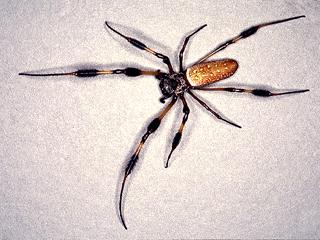
by Stephen Greer | Jul 7, 2023
Unknowingly we interact with many small creatures in our everyday lives. Spiders are one of these groups that are beneficial to the function of human activity. This group receives much publicity as being dangerous to people and our pets. While there is always a possibility of being bitten and having venom injected by a few types of spiders, most all others are harmless to people. The primary benefit of spiders is their propensity for catching insects outside and in the home that are identified as harmful to people. Spiders come in all shapes and sizes with many hiding away, never to be seen by people.
Spiders are often included in the same group as insects, but this is not true. They belong in the group arachnids and are closely related to ticks, scorpions and mites. Spiders have two body sections (cephlothorax and abdomen) and have eight legs while insects have three body sections (head, thorax and abdomen). Scorpions usually remain outdoors and may be found indoors during hot dry periods. They are nocturnal hunters of pests that include roaches. None of the scorpions native to Florida are capable of providing a lethal sting, but it is painful when it occurs, leaving a sore and swollen at the sting area. I was reminded of this after stepping on one in the late evening while moving around the kitchen with no lights on. If the person that is stung has allergic reactions to bee stings, observe them and take precautionary health measures needed.
The spider is an important predator of harmful insects and can be found about any where in and around the home, in the garden, and many other places in the great outdoors. An Extension Entomologist I knew from North Carolina State University always mentioned, when presenting to Master Gardener Volunteer classes, that at almost any time given time, we are within two to three feet of a spider, with most so small we never see them. They are great at keeping the beneficial and harmful insect populations in balance in nature.
If you decide to spray to manage your spider population, keep in mind that by reducing the number of spiders in the landscape, you can create a reverse problem with harmful insect populations increasing dramatically. If big webs are a bother, simply take a broom and knock them down. They will rebuild by the next day, but you may not need to be in that area for a while. Always be careful and wear gloves when working in the garden, especially areas that are dark and covered, such as irrigation valve boxes, wood stacks, and other similar places. These are prime locations where the Black Widow or Recluse spiders may be set up, waiting to ambush roaches and other insects. If you are bitten by either seek immediate medical care.
Finally, spiders are fun to observe in nature! One of the most interesting spiders to watch is observable during fall in Florida – the Yellow Garden Spider. They build large webs and often place a zig zap signature in the middle. This large spider catches many insects in the garden and landscape. With early morning sunlight and dew hanging on the web during the fall, it makes for a beautifully create piece of art. Enjoy nature and all the creative processes that occur from a safe distance – spiders included!

by Larry Williams | Feb 11, 2021

Be careful when bringing firewood indoors. Photo credit: Larry Williams
Your firewood pile could be “bugged.” Many insects like to overwinter in wood. A wood pile is an ideal place for some insects to survive the winter. They don’t know that you intend to bring their winter home indoors during cold weather.
During colder weather, you can unknowingly bring in pests such as spiders, beetles and roaches when you bring in firewood. It’s best to bring in firewood only when you are ready to use it. Otherwise, those pests could become active and start crawling around inside your house. Many insects are potential problems indoors and there are usually control options once insects move into your home. However, preventing the insects from getting inside is the best approach.
If you store wood indoors for short periods of time, it is a good idea to clean the storage area after you have used the wood. Using a first-in, first-out guideline as much as possible will reduce chances of insect problems.
It’s best to keep your wood pile off the ground and away from the house. This will make it less inviting to insects and help the wood dry. It’s not difficult to keep the wood off the ground. The wood can be stacked on a base of wooden pallets, bricks or blocks, which will allow air movement under the wood. The wood can also be covered with a waterproof tarp or stored in a shed. Regardless of how it is stored, avoid spraying firewood with insecticides. When burned, insecticide treated wood may give off harmful fumes.
Some critters that live in firewood can be harmful to humans. To avoid a painful sting or bite from insects, spiders or scorpions (no Florida scorpion is considered poisonous, but they can inflict a painful sting), it is a good practice to wear gloves when picking up logs from a wood pile.
Firewood can be a good source of heat during our cold weather. If you’re careful with how you handle your firewood, hopefully it will warm you, not “bug” you.
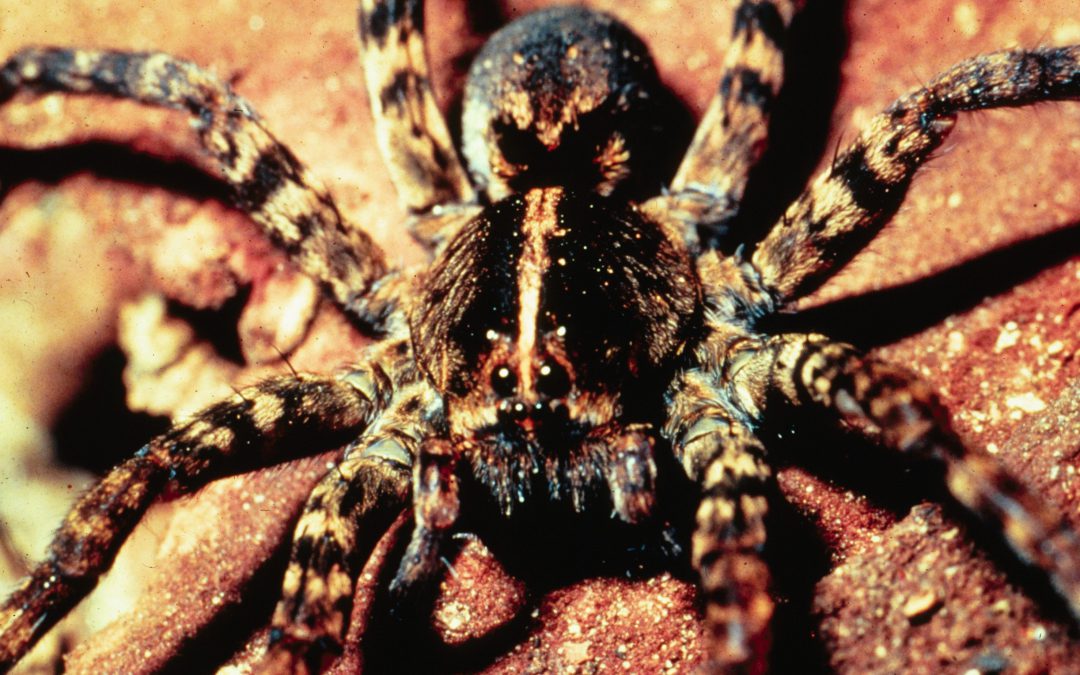
by Molly Jameson | Oct 28, 2020
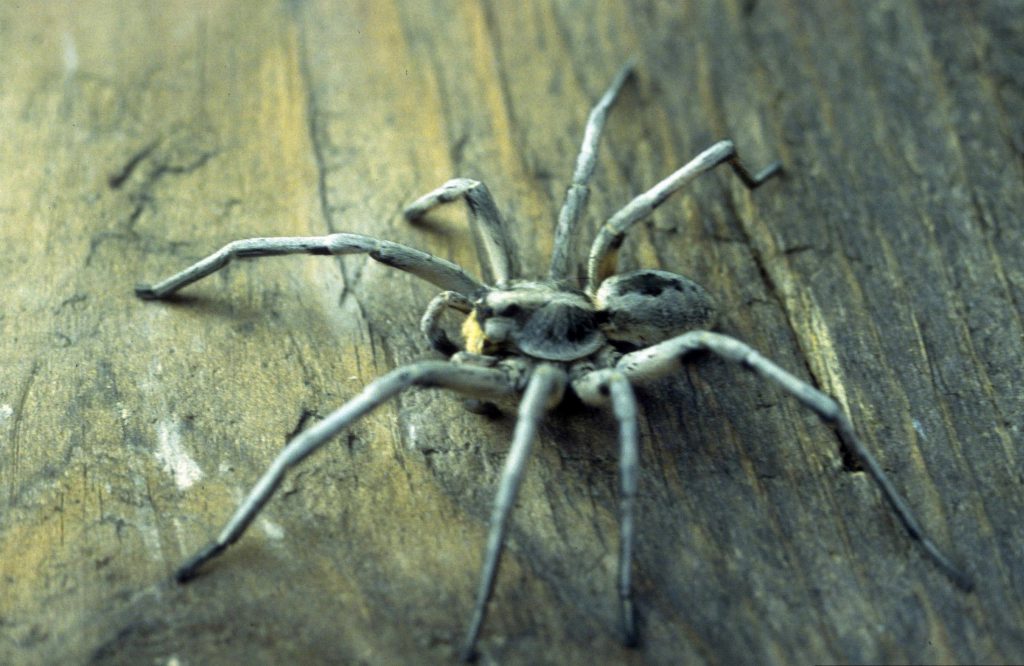
The Carolina wolf spider (Hogna Corolinensis) is the largest wolf spider, measuring up to 22-35 mm. It is the state spider of South Carolina, the only state that recognizes a spider as a state symbol. Photo by Eugene E. Nelson, Bugwood.org.
Halloween coincides with a full moon this year, so you may want to be on the lookout for hungry werewolves. In your garden, you may also be on the lookout for a much smaller, yet just as frightful, type of wolf. Well – wolf spider, that is!
But have no fear, just as the little werewolves of the neighborhood will be sated by a handful of sweets, a wolf spider will be satisfied once it finds its meal of choice. Wolf spiders are predators, feeding primarily on insects and other spiders. Much like a werewolf, wolf spiders prefer to stalk their prey at night. This is good news for gardeners – as it means you’ll have an insect hunter working for you while you sleep.
Wolf spiders are in the family Lycosidae, and there are over 2,000 species within this family. Lycos means “wolf” in Greek, inspired by the way wolves stalk their prey. Although, unlike wolves who hunt in packs, wolf spiders are very much solitary. These spiders do not spin webs; instead, they keep to the ground, where they can blend in with leaf litter on the soil floor. Some wolf spiders even dig tunnels, or use tunnels dug by other animals, to hide and hunt.
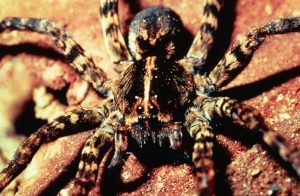
Although most spiders have poor eyesight, wolf spiders have excellent vision, which they use to spot prey. Photo by James O. Howell, University of Georgia, Bugwood.org.
Wolf spiders have eight eyes that are arranged in three rows. This includes four small eyes in the lowest row, two very large eyes in the middle, and two medium-sized eyes off to either side on top. Some of their eyes even have reflective lenses that seem to sparkle in the moonlight. Using their excellent eyesight and sensitivity to vibrations, they stealthily stalk prey such as ants, grasshoppers, crickets, and other spider species. Female wolf spiders, which are bigger than males, may even take down the occasional lizard or frog.
No matter the meal, many wolf spiders pounce on their prey, hold it between their eight legs, and roll with it onto their backs, creating a trap. They then sink their powerful fangs, which are normally retracted inside the jaw, into the victim. The fangs have a small hole and hollow duct, which allows venom from a specialized gland to pass through during the bite. This venom quickly kills the prey, allowing the wolf spider to eat in peace.
Although wolf spiders could bite a person if threatened, they prefer to run away, and their venom is not very toxic to humans. If you do get bitten, you may have some swelling and redness, but no life-threatening symptoms have been reported. Werewolves on the other hand? For these, you’re on your own!
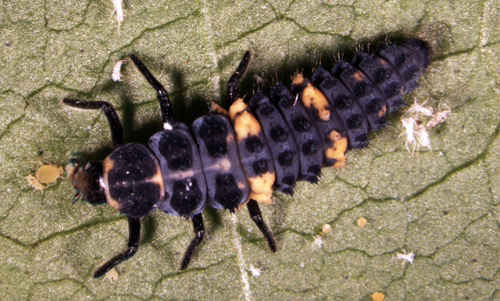
by Daniel J. Leonard | Aug 6, 2020
I know this is going to come as a shock to some readers, but not all bugs are bad. In fact, while there are over 1 million species of insects worldwide, less than 1% are problem pests! This problem 1%, composed of common garden pests, including aphids, stinkbugs, nuisance caterpillars, and scales, get all the attention and for good reason; they can be extremely destructive to home and commercial crops. However, the good guys, beneficial predatory insects, are out there too, providing valuable pest control day and night and should be considered in part of a quality garden pest management strategy.
 Beneficials come in many shapes and sizes. Some are commonly known predators, such as spiders, Lady Beetles and Praying Mantids, while others are lesser known pest nemeses, like Paper Wasps, Pirate Bugs, and Lacewings. Regardless, gardeners should do their homework and be able to identify beneficials when they see them and allow them to do their jobs. The presence, or not, of a handful of Lady Beetles or Lacewings on the attack can be the difference between needing to treat with insecticides for an aphid outbreak or just letting nature take its course. Studies have shown that just one individual Lady Beetle in the larval stage can consume as many as 500 aphids; adult Lady Beetles are even hungrier aphid eaters! Paper Wasps, you know the ones who make the large “papery” nests around eaves of house and other structures, play an important beneficial role, frequently preying on caterpillars. If their nests aren’t near highly trafficked areas around your home and you don’t have family members allergic to wasp stings, your garden will thank you for leaving a few paper wasp colonies as caterpillar insurance!
Beneficials come in many shapes and sizes. Some are commonly known predators, such as spiders, Lady Beetles and Praying Mantids, while others are lesser known pest nemeses, like Paper Wasps, Pirate Bugs, and Lacewings. Regardless, gardeners should do their homework and be able to identify beneficials when they see them and allow them to do their jobs. The presence, or not, of a handful of Lady Beetles or Lacewings on the attack can be the difference between needing to treat with insecticides for an aphid outbreak or just letting nature take its course. Studies have shown that just one individual Lady Beetle in the larval stage can consume as many as 500 aphids; adult Lady Beetles are even hungrier aphid eaters! Paper Wasps, you know the ones who make the large “papery” nests around eaves of house and other structures, play an important beneficial role, frequently preying on caterpillars. If their nests aren’t near highly trafficked areas around your home and you don’t have family members allergic to wasp stings, your garden will thank you for leaving a few paper wasp colonies as caterpillar insurance!
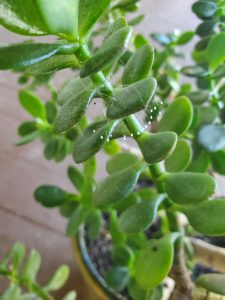
Lacewing eggs on a Jade plant in close proximity to the author’s vegetable garden.
In many instances, beneficial insects can keep pest insect infestations at bay, allowing gardeners to spot treat outbreaks when they get out of hand or even prevent the problem from needing chemical intervention altogether.
As helpful as they are, beneficial insects in the garden won’t totally negate the need for chemical treatment entirely. From time to time, garden pest populations outpace the beneficials’ abilities to kill them and intervention from humans is needed. In these times, it is advisable to use a couple of best practices to limit exposure to beneficial insects. First, try to use selective insecticides that only target specific pests and are nontoxic to other bugs, like the product Bt for caterpillar pests (sold under many brands like Dipel, Garden Safe Bt Worm and Caterpillar Killer, Thuricide, etc). However, if a nonselective, general insecticide, like the Pyrethroids (many common homeowner insecticide brands) and carbamates (Sevin and others), is needed, timing these broad spectrum sprays for early in the morning and late in the evening when many beneficials are not very active can help reduce friendly fire casualties. Care should also be taken to only spot treat infested plants and not the entire garden, this helps reduce beneficial exposure to these broadly toxic pesticides.
Every gardener should have a plan for pest control and beneficials can play an important role in this overall strategy. Gardeners can help ensure that nature pulls its weight in controlling problem pests by taking a little time to scout for beneficial insect populations, keeping a close eye on developing pest outbreaks, using selective insecticides when you can, and only spraying broad spectrum products as spot treatments when necessary and timing those applications for very early or late in the day. If you have a question about whether or not a garden insect is a good guy or a pest or want more information on garden pest control strategies, contact your local UF/IFAS County Extension Office! Happy Gardening!
The following resources were used in the development of this article:
https://gardeningsolutions.ifas.ufl.edu/care/florida-friendly-landscapes/beneficial-insects.html
https://sfyl.ifas.ufl.edu/sarasota/gardening-and-landscaping/horticulture-commercial/integrated-pest-management/beneficial-insects/
http://www.missouribotanicalgarden.org/gardens-gardening/your-garden/help-for-the-home-gardener/advice-tips-resources/pests-and-problems/other/beneficial-insects.aspx

by Larry Williams | Jul 23, 2020
A number of years ago a gentleman told me about an orb weaver spider that was living by his front door. He said that it had been there for about two months and that it was interesting to watch the construction of the intricate “bug catching” web. However, he explained that he had a number of people coming to visit and he wanted to know about relocating the spider to his backyard.
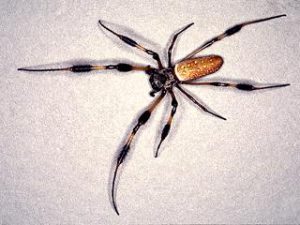
Golden silk orb-weaver spider. Photo credit: UF/IFAS
These types of spiders typically construct their webs in an area and stay in that location based on the environment. Many of the orb weaver spiders rely on flying insects and usually construct their webs several feet or more above the ground. This is a good height to capture many flying insects. As a result, there needs to be items within a reasonable distance to attach and place the web. If a spider is randomly relocated, there may be nothing in reasonable distance to support a web. There needs to be at least a couple of tall shrubs or tree trunks for the spider to construct a web in-between the plants several feet above ground level. It needs to be in an area with limited people movement to prevent disturbance by people walking into it. It needs to be in a location with enough flying insect activity to satisfy the spider. If it’s not the right location, the spider may move back to another location, perhaps the front door area.
Webs built by these types of spiders can be quite large and may be suspended several feet or more above the ground. Some people become annoyed and/or frightened as they accidentally come in contact with these webs, brushing the webs from their face and arms. I’m sure the spider becomes annoyed, too, having to rebuild its web.
Despite their size, orb weaver spiders pose little threat to people. They’re considered beneficial because they feed on a wide range of flying insects. They usually construct webs in relatively sunny, open areas with little wind.
Even though these spiders are beneficial, many people don’t like spiders. If you choose to control spiders in and around your home, keep in mind it’s unwise and impractical, if not impossible, to control all spiders.
By the way, the gentleman concerned about the spider decided to leave the spider at the front door area. He posted a sign next to the web in hopes that his guests would steer clear of the web. He offered his garage entrance to those frightened by the spider.
For more information on orb weaver spiders, visit the below UF/IFAS Extension website.
https://edis.ifas.ufl.edu/topic_orb_weavers
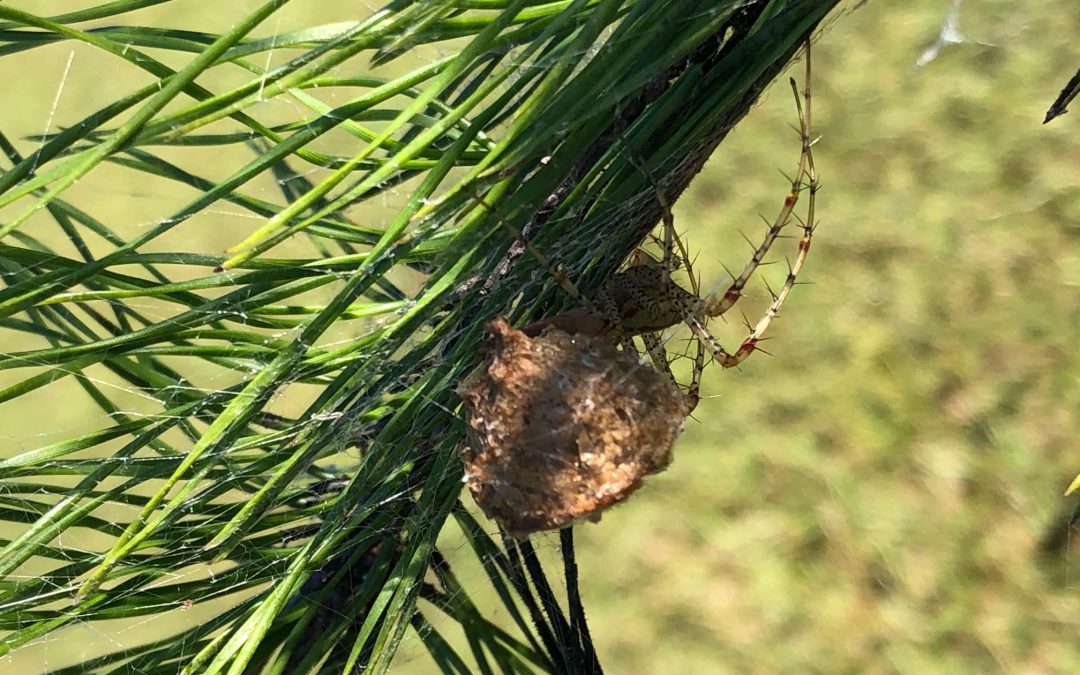
by Carrie Stevenson | Nov 7, 2019
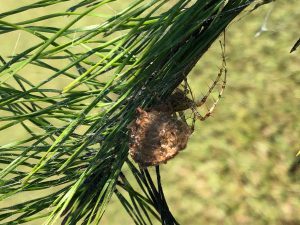
A female striped lynx spider protects her egg sac. Photo credit: Carrie Stevenson, UF IFAS Extension
With Halloween just behind us, some of us may still have fake spiders in our yards and cotton webbing all over the shrubbery. Spiders (along with bats) are among those creatures feared and demonized in folklore this time of year. It is important to remember, however, that both organisms are important predators and managers of our insect population.
Last week during a walk on the Extension property, I came across a large brown spider hovering protectively near her egg sac. Perched in a newly planted pine tree, I saw no obvious web. Instead, the spider loosely wrapped the pine’s needles with silk, forming a support structure for the relatively large egg sac.
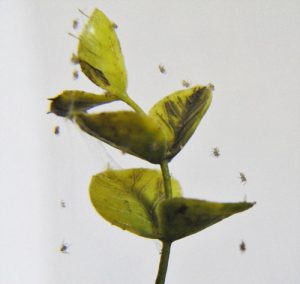
Newly hatched striped lynx spiderlings on silk scaffolding covering a plant. Photograph by Laurel Lietzenmayer, University of Florida.
On further research, I learned that this female striped lynx spider (Oxyopes salticus) would have mated just once, after responding to a male’s courtship display (involving drumming and elaborate leg touches). She would have produced the egg sac 1-4 weeks after mating, attaching it to the pine needles, and will tend to it until her young emerge 20 days later. Up to five days after hatching, lynx spiderlings disperse by “ballooning” from the plant—they release a silk thread into the air, allowing the wind to carry them off like a tiny skydiver. Those spiderlings will mature into adults by 9 months, living their entire lifespan in just one year.
During that year, though, lynx spiders are important predators of pest insects. Instead of catching bugs in a web, they stalk their prey like a big cat—hence the name, “lynx.” They prey on many fly species, but also on bollworms and green stinkbugs that are major pests of cotton and soybean crops. These spiders are beneficial and highly vulnerable to insecticides.














